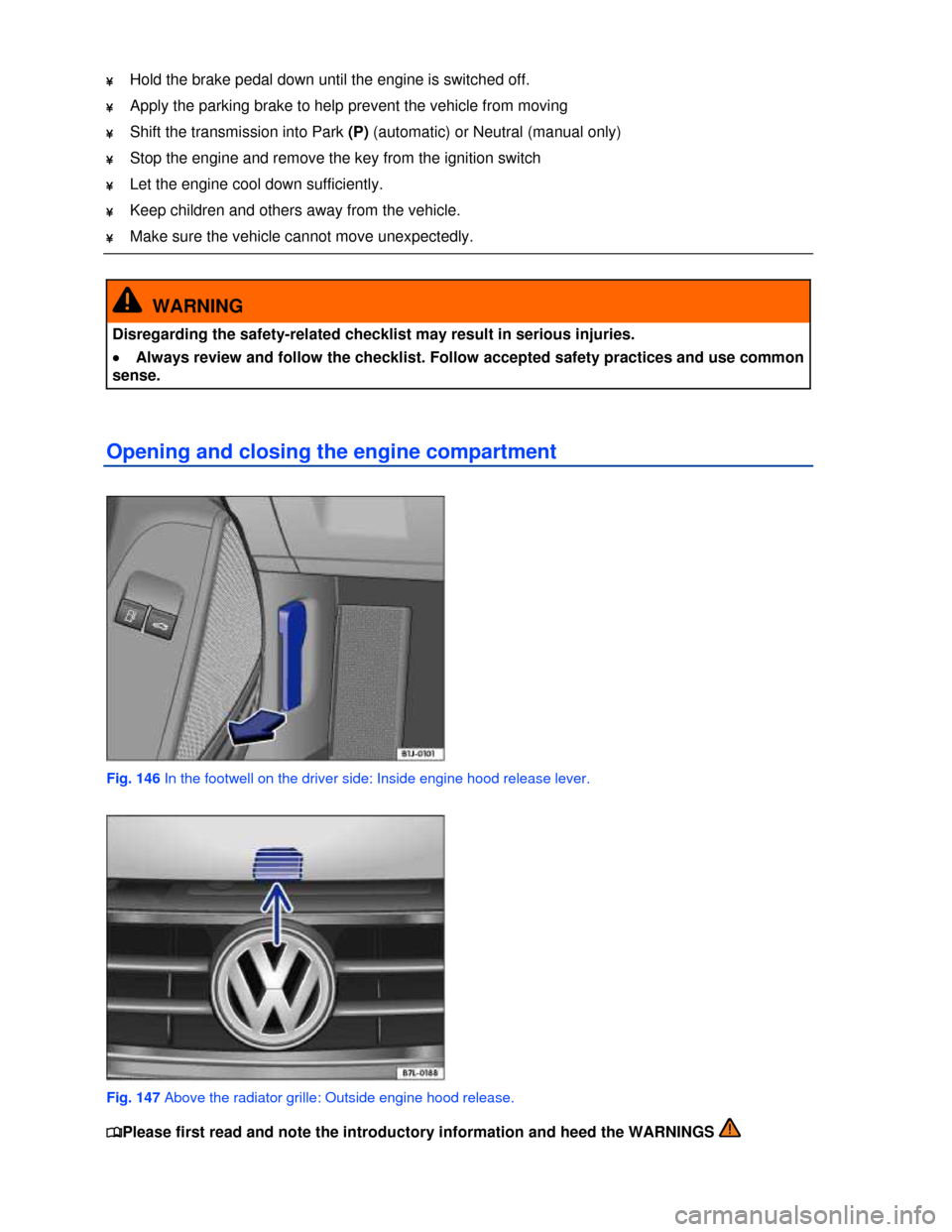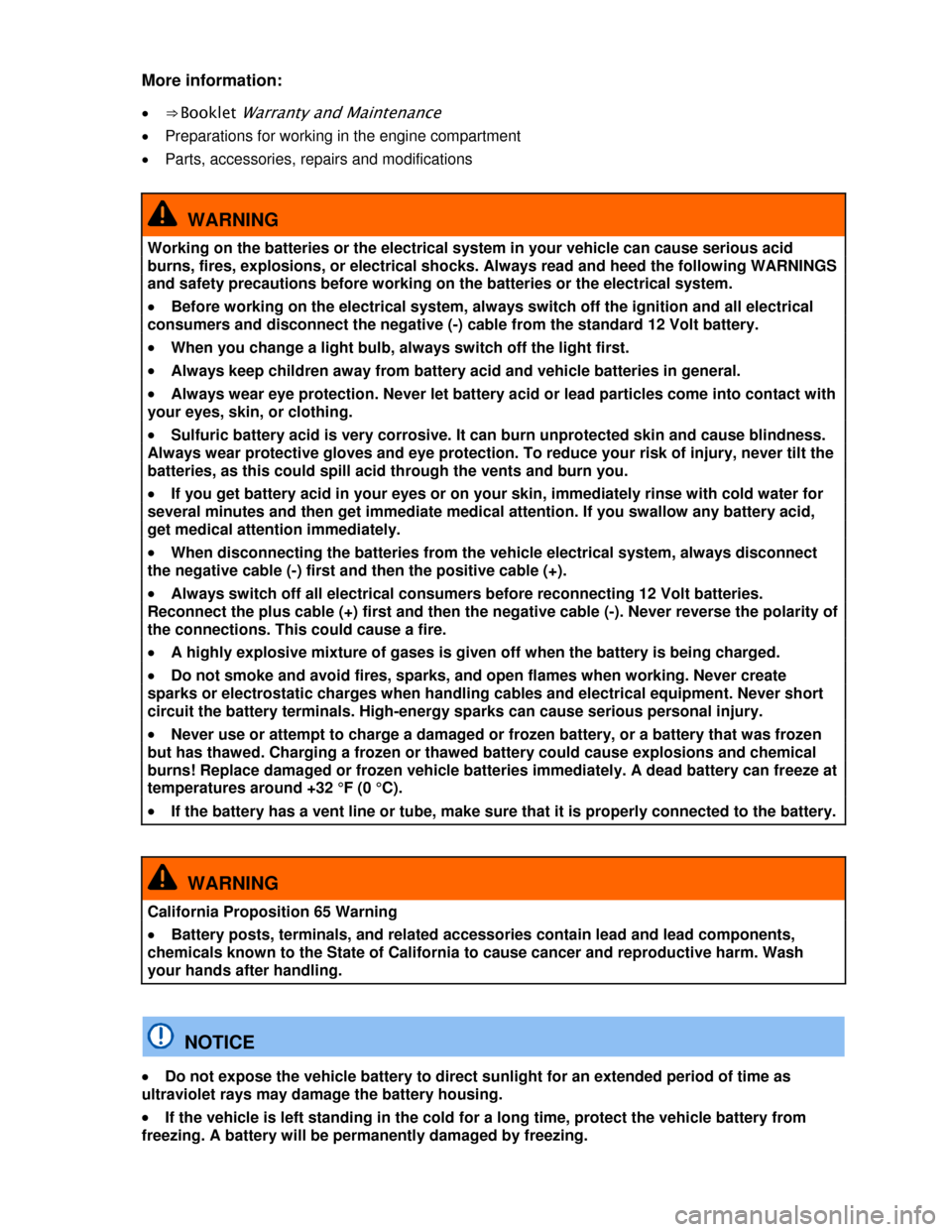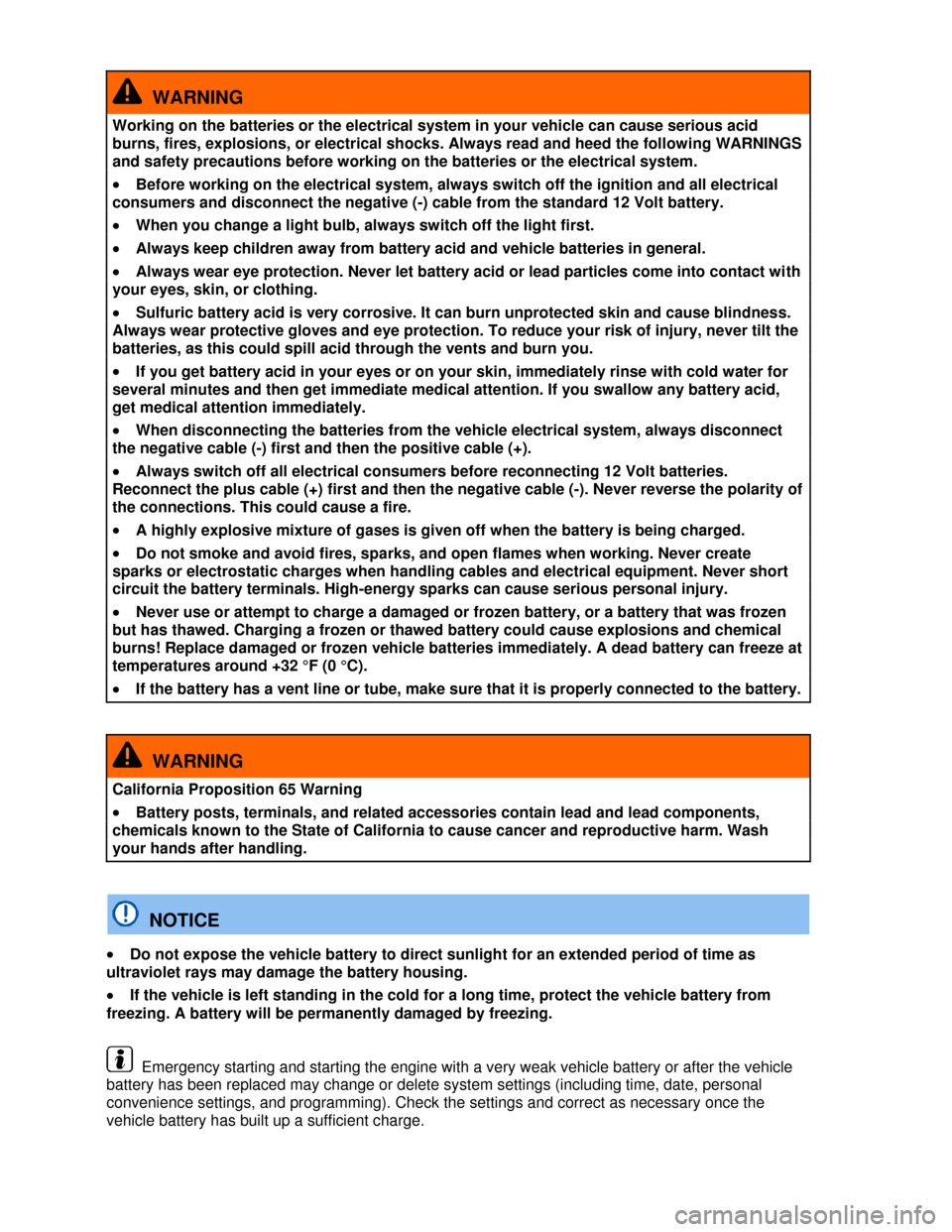2013 VOLKSWAGEN EOS ignition
[x] Cancel search: ignitionPage 189 of 329

1) Do not use Rear Assist in the following situations:
– If the position or angle of the camera has changed, such as after a rear-end collision. Have the
system checked by an authorized Volkswagen dealer or an authorized Volkswagen Service Facility.
2) Examples of optical distortion by the camera
The Rear Assist camera displays only two-dimensional images. Recesses and protruding objects on
the ground or protruding parts on other vehicles are difficult or impossible to identify due to the lack
of depth of field.
Objects or another vehicle may seem closer or farther away on the screen than they really are:
– When driving from a level surface onto an upward or downward slope.
– When driving up or down a slope onto a level surface.
– If the rear of the vehicle is heavily loaded.
– When approaching protruding objects. These objects can disappear from the field of view when
backing up.
Cleaning the camera lens
Keep the camera lens clean and free of snow and ice:
�x Engage the parking brake.
�x Switch on the ignition.
�x Select the reverse gear.
�x Wet the camera lens with a commercially available alcohol-based glass cleaner and clean with a
dry cloth ⇒ .
�x Remove snow with a brush.
�x Remove ice with deicer spray ⇒ .
NOTICE
�x Never use abrasive cleaning agents to clean the camera lens.
�x Never remove snow or ice on the camera lens with warm or hot water. This can damage the
camera lens.
Volkswagen recommends practicing parking with Rear Assist in a safe place with little or no
traffic or in a parking lot under good visibility and weather conditions in order to familiarize yourself
with the system, the orientation lines and the way they work.
Rear Assist does not work when the luggage compartment lid is open.
Page 206 of 329

NOTICE
Failure to heed warning lights or text WARNINGS can result in vehicle damage.
If the ignition is switched on, an acoustic warning sounds when low tire pressure is detected. If a
system malfunction is detected, no acoustic warning sounds.
Driving for a longer period of time on rough roads or with a dynamic and sporty style can make
the TPMS system temporarily unavailable. The indicator light will come on, signaling a malfunction, but
will go out again once the road condition or driving style changes.
Applicable only in the United States
Tire Pressure Monitoring System (TPMS)
Fig. 138 The Tire Pressure Monitoring system (TPMS) uses a pressure sensor in each read wheel.
�
Page 225 of 329

WARNING
The engine compartment of any motor vehicle is a potentially dangerous area and can cause
serious personal injury.
�x Always use extreme caution when doing any work in the engine compartment. Always
follow commonly accepted safety practices and use common sense. Never risk personal
injury.
�x Never perform any work in the engine compartment unless you know exactly how to carry
out the job and have the correct technical information and the correct tools.
�x If you are uncertain about what to do, have the work performed by an authorized
Volkswagen dealer, an authorized Volkswagen Service Facility, or another qualified
workshop. Serious personal injury may result from improperly performed work.
�x We strongly recommend that you always have HID – High Intensity Discharge (Xenon)
headlights and H7 bulbs replaced by a qualified technician. Serious personal injury may
result from improperly performed work.
�x Never open or close the engine hood if steam or coolant is escaping. Hot steam or coolant
can cause serious burns. Always wait until you no longer see or hear steam or coolant
escaping from the engine.
�x Always let the engine cool down completely before carefully opening the hood.
�x Hot parts of the engine and the exhaust system will burn skin on contact.
�x When the engine has cooled down and you are ready to open the hood:
– Firmly apply the parking brake and shift the transmission into Park (P) (automatic) or
Neutral (manual only).
– Take the vehicle key out of the ignition.
– On vehicles with Keyless Access, make sure that the remote control vehicle key is out
of range of the vehicle and that the vehicle cannot be started by depressing the starter
button
– Always keep children and others away from the engine compartment and never leave
them unsupervised.
�x The engine coolant system is under pressure when the engine is hot. Never unscrew the
coolant expansion tank cap when the engine is hot. Hot coolant can spray out and cause
severe burns and other serious injuries.
– Turn the cap slowly and very carefully in a counterclockwise direction while applying
light downward pressure on the top of the cap.
– Always protect your face, hands, and arms from hot escaping coolant or steam by
covering the cap with a large, thick rag.
�x Never spill fluids on the engine or exhaust system when refilling. Spilling fluids onto hot
parts of the engine or exhaust system can cause a fire.
Page 226 of 329

WARNING
High voltage systems in the engine compartment can cause electrical shocks or even
electrocution, severe burns, other serious injuries, and even death!
�x Never short-circuit the electrical system. Be especially careful when using jumper cables.
The vehicle's battery could explode!
�x To reduce the risk of electrical shock and personal injury while the engine is running or
being started:
– Never touch ignition cables. Never touch other components of the high voltage
electronic ignition system.
– Never touch the wiring of the HID – High Intensity Discharge (Xenon) headlights.
– Read and heed the important information and warnings on cleaning the engine
compartment , Cleaning the engine compartment
WARNING
Moving parts in the engine compartment can cause serious personal injury on contact.
�x Never reach into the area around or touch the radiator fan. Contact with the blades can
cause serious personal injury. Always remember that the radiator fan is temperature-
controlled and can come on suddenly even when the engine has been switched off for a while
and the key has been removed from the ignition.
�x If you have to perform a check or repair when the engine is running, there are more risks
from the rotating parts, such as the drive belts, alternator, radiator fan, etc., and from the
high-voltage ignition system. Always use extreme care.
– Always make sure that jewelry, loose clothing and long hair do not get caught in
rotating engine parts. Before starting any work remove your jewelry, take off your necktie,
tie back and cover your hair, and do not wear clothing that can hang down and get caught
in moving engine parts.
– Always use extreme caution if the accelerator pedal has to be depressed to perform a
check. The vehicle will start to move even if the parking brake is on.
�x Never leave any objects in the engine compartment, for example cleaning rags and tools.
Objects left behind can cause malfunctions, engine damage, and even fires.
WARNING
Operating fluids and some materials in the engine compartment can catch fire easily, causing
burns and other serious personal injuries!
�x Never smoke near the engine compartment.
�x Never work next to open flames or sparks.
�x Never pour or spill operating fluids or other flammable liquids on the engine. These fluids
can ignite on hot engine parts and cause injuries.
�x If work on the fuel system or the electrical system is necessary:
– Always disconnect the 12 Volt vehicle battery. Make sure the vehicle is unlocked when
you disconnect the battery, or the alarm will go off. Never touch the electrical wiring of the
ignition system.
– Never work near heaters, water heaters, or other open flames.
�x Always have a functional, approved fire extinguisher nearby.
Page 228 of 329

¥ Hold the brake pedal down until the engine is switched off.
¥ Apply the parking brake to help prevent the vehicle from moving
¥ Shift the transmission into Park (P) (automatic) or Neutral (manual only)
¥ Stop the engine and remove the key from the ignition switch
¥ Let the engine cool down sufficiently.
¥ Keep children and others away from the vehicle.
¥ Make sure the vehicle cannot move unexpectedly.
WARNING
Disregarding the safety-related checklist may result in serious injuries.
�x Always review and follow the checklist. Follow accepted safety practices and use common
sense.
Opening and closing the engine compartment
Fig. 146 In the footwell on the driver side: Inside engine hood release lever.
Fig. 147 Above the radiator grille: Outside engine hood release.
�
Page 234 of 329

Under normal driving conditions, the needle should be in the middle of the gauge. The temperature
may go higher when the engine is working hard, especially in hot weather.
When the ignition is switched on, several warning and indicator lights come on briefly for a function
check. They go out after a few seconds.
The following table explains what to do if the engine coolant warning light ¿ does not go out a few
seconds after the engine is started or lights up or starts flashing while driving.
Flashes
Temperature
gauge needle
⇒ fig. 150
Possible cause Proper response
�~
(C)
Warning zone
Engine coolant
temperature too high.
�
Page 237 of 329

More information:
�x ⇒ Booklet Warranty and Maintenance
�x Preparations for working in the engine compartment
�x Parts, accessories, repairs and modifications
WARNING
Working on the batteries or the electrical system in your vehicle can cause serious acid
burns, fires, explosions, or electrical shocks. Always read and heed the following WARNINGS
and safety precautions before working on the batteries or the electrical system.
�x Before working on the electrical system, always switch off the ignition and all electrical
consumers and disconnect the negative (-) cable from the standard 12 Volt battery.
�x When you change a light bulb, always switch off the light first.
�x Always keep children away from battery acid and vehicle batteries in general.
�x Always wear eye protection. Never let battery acid or lead particles come into contact with
your eyes, skin, or clothing.
�x Sulfuric battery acid is very corrosive. It can burn unprotected skin and cause blindness.
Always wear protective gloves and eye protection. To reduce your risk of injury, never tilt the
batteries, as this could spill acid through the vents and burn you.
�x If you get battery acid in your eyes or on your skin, immediately rinse with cold water for
several minutes and then get immediate medical attention. If you swallow any battery acid,
get medical attention immediately.
�x When disconnecting the batteries from the vehicle electrical system, always disconnect
the negative cable (-) first and then the positive cable (+).
�x Always switch off all electrical consumers before reconnecting 12 Volt batteries.
Reconnect the plus cable (+) first and then the negative cable (-). Never reverse the polarity of
the connections. This could cause a fire.
�x A highly explosive mixture of gases is given off when the battery is being charged.
�x Do not smoke and avoid fires, sparks, and open flames when working. Never create
sparks or electrostatic charges when handling cables and electrical equipment. Never short
circuit the battery terminals. High-energy sparks can cause serious personal injury.
�x Never use or attempt to charge a damaged or frozen battery, or a battery that was frozen
but has thawed. Charging a frozen or thawed battery could cause explosions and chemical
burns! Replace damaged or frozen vehicle batteries immediately. A dead battery can freeze at
temperatures around +32 °F (0 °C).
�x If the battery has a vent line or tube, make sure that it is properly connected to the battery.
WARNING
California Proposition 65 Warning
�x Battery posts, terminals, and related accessories contain lead and lead components,
chemicals known to the State of California to cause cancer and reproductive harm. Wash
your hands after handling.
NOTICE
�x Do not expose the vehicle battery to direct sunlight for an extended period of time as
ultraviolet rays may damage the battery housing.
�x If the vehicle is left standing in the cold for a long time, protect the vehicle battery from
freezing. A battery will be permanently damaged by freezing.
Page 248 of 329

WARNING
Working on the batteries or the electrical system in your vehicle can cause serious acid
burns, fires, explosions, or electrical shocks. Always read and heed the following WARNINGS
and safety precautions before working on the batteries or the electrical system.
�x Before working on the electrical system, always switch off the ignition and all electrical
consumers and disconnect the negative (-) cable from the standard 12 Volt battery.
�x When you change a light bulb, always switch off the light first.
�x Always keep children away from battery acid and vehicle batteries in general.
�x Always wear eye protection. Never let battery acid or lead particles come into contact with
your eyes, skin, or clothing.
�x Sulfuric battery acid is very corrosive. It can burn unprotected skin and cause blindness.
Always wear protective gloves and eye protection. To reduce your risk of injury, never tilt the
batteries, as this could spill acid through the vents and burn you.
�x If you get battery acid in your eyes or on your skin, immediately rinse with cold water for
several minutes and then get immediate medical attention. If you swallow any battery acid,
get medical attention immediately.
�x When disconnecting the batteries from the vehicle electrical system, always disconnect
the negative cable (-) first and then the positive cable (+).
�x Always switch off all electrical consumers before reconnecting 12 Volt batteries.
Reconnect the plus cable (+) first and then the negative cable (-). Never reverse the polarity of
the connections. This could cause a fire.
�x A highly explosive mixture of gases is given off when the battery is being charged.
�x Do not smoke and avoid fires, sparks, and open flames when working. Never create
sparks or electrostatic charges when handling cables and electrical equipment. Never short
circuit the battery terminals. High-energy sparks can cause serious personal injury.
�x Never use or attempt to charge a damaged or frozen battery, or a battery that was frozen
but has thawed. Charging a frozen or thawed battery could cause explosions and chemical
burns! Replace damaged or frozen vehicle batteries immediately. A dead battery can freeze at
temperatures around +32 °F (0 °C).
�x If the battery has a vent line or tube, make sure that it is properly connected to the battery.
WARNING
California Proposition 65 Warning
�x Battery posts, terminals, and related accessories contain lead and lead components,
chemicals known to the State of California to cause cancer and reproductive harm. Wash
your hands after handling.
NOTICE
�x Do not expose the vehicle battery to direct sunlight for an extended period of time as
ultraviolet rays may damage the battery housing.
�x If the vehicle is left standing in the cold for a long time, protect the vehicle battery from
freezing. A battery will be permanently damaged by freezing.
Emergency starting and starting the engine with a very weak vehicle battery or after the vehicle
battery has been replaced may change or delete system settings (including time, date, personal
convenience settings, and programming). Check the settings and correct as necessary once the
vehicle battery has built up a sufficient charge.